Per leggere la versione italiana cliccate qua: ZEUS by OCEANLIFE
One of the most critical aspect in the management of an aquarium is the management of emergencies that comes in the event of an interruption of power line.
The lack of electricity is the first and immediate consequence of the collapse of the oxygen content in the aquarium and then of the pH, and soon after this brings the tank to no longer be heated or cooled properly.
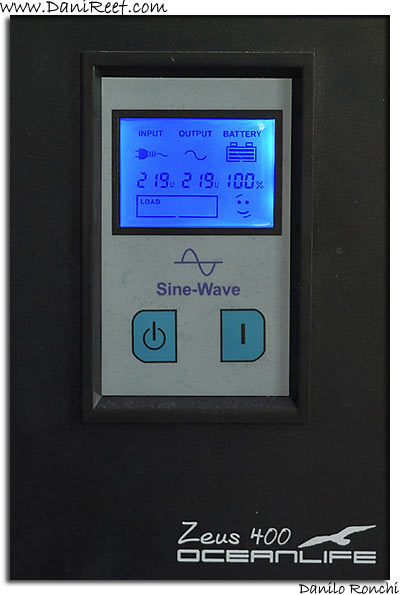
If a power outage is long enough can lead to death by anoxy of fish and corals. It’s obvious that the problem is greater in densely populated aquarium of fish and corals than in tanks with not only fishes or freshwater tanks, where the dynamic is completely different.
We can therefore say that the average survival expectancy of an aquarium is inversely proportional to the number of fish and corals hosted, so you must be ready in case of blackouts. 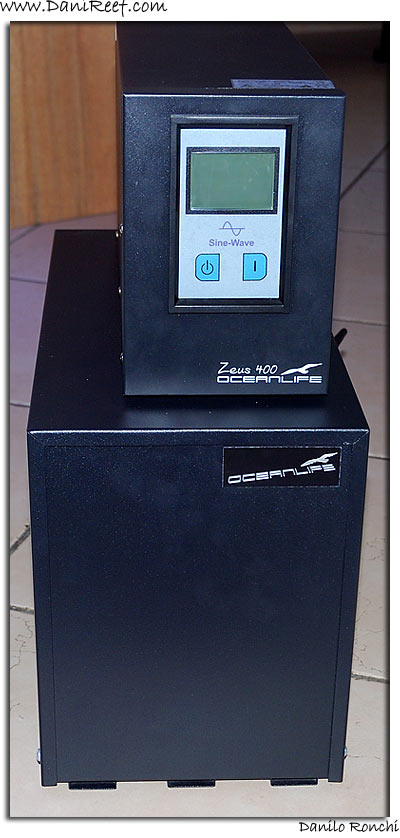
If our reef aquarium is very populated, the time of crisis is often around 2 hours, after which time the damage usually become serious, it is obvious that in your aquarium this value can be very different because, for example, the temperature influences the presence of oxygen into the water (the dissolved oxygen decreases with increasing temperature).
Oceanlife has built Zeus, the first sine wave UPS patented for aquariums. It’s ideal for protecting all equipments connected to him and subjected to lack of power generation network thanks to a perfect sine wave.
The sine wave is the best guarantee for the functioning without problems for all types of existing equipment, even the most sensitive electronic equipment such as pumps, synchronous pumps or computers for aquarium. Zeus was designed to provide current loads up to 400W for the duration of the blackout, whatever the capacity of batteries used.
It is run entirely in digital and has a minimum charging time, during which consumes up to 360 watts with current of 15A, so as to be always ready in case of need.
Zeus has a great blue led display that indicates the status of the group, its normal functioning, operation in battery mode, the overload and possible failures.
It’s protected, and thus protects against overloads, short circuits, overvoltage and overheating.
The batteries can be purchased separately and we can choose their capacity based on our needs for electricity coverage. They’re housed separately, are replaceable by any other type of sealed batteries on the market, provided they respect the tension of work of 24V.
Technical Features
The UPS unit measures 37.5x13x19 cm, which is not a small unit, because you have to consider also the 2.5 cm required to leave by each side to ensure perfect operation. The footprint increases significantly with 2 batteries of 40Ah like those that came to my unit, I think it’s better to buy the special cabinet for batteries in order not to leave unprotected batteries and wires.
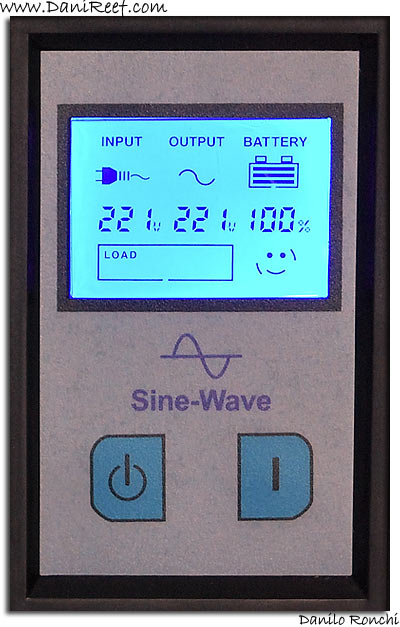
Input Voltage: 155-280V
Input Frequency: 50Hz + / – 10%
Waveform: pure sine wave
Output Voltage: 230V + / – 10%
Output Frequency: 50Hz + / – 0.5%
Battery: maintenance-free
Charging current up to 15A
Battery protection: Auto-test automatic downloads, overloaded, intelligent control system.
Battery voltage: 24V (battery not included, Zeus needs to work 2 sealed lead-acid batteries from 12 V connected in series)
Cooling: Active
Noise: Less than 14 db
Dimensions: 375x130x190 mm
Weight: 7.5 kg
The optional batteries cabinet has dimensions of 43×20,5×27,5 cm and is very cumbersome.
The first thing that comes to mind when you look at is the thought of finding a suitable accommodation, and the second is the question whether it could be safely housed inside the cabinet under the tank.
OceanLife do not recommend placement in moist environments subject to condensation. By respecting these guidelines is therefore not recommended placement near a sump or inside a piece of furniture that is not perfectly ventilated and sufficiently insulated from the sump.
In my case, the positioning was almost obligated under the aquarium, but I was lucky because there is enough space between Zeus and the sump, and because the forniture is practically open and there are no signs of condensation, there is also a plexiglass divider between the two areas, sump and electricity.
Along with Zeus, you can install any battery as long as it respects the working voltage of 24 volts.
You must use VRLA batteries as Zeus could work effectively and efficiently, or bateries sealed with electrolyte in GEL, which we are absolutely sure have no gas emissions, and thus are eligible to use indoors. For instance the common battery car, although cost less, are not recommended because they are not designed to handle loads and discharges of heavy entity, but are designed to provide high current in short intervals of time, and filled with liquid electrolyte are both potentially dangerous for the emission of hydrogen (flammable) and for the same electrolyte (sulfuric acid). VRLA batteries instead can manage the complete discharge brought up at shutdown of the unit. In fact, the logic control of Zeus can not get to the complete discharge but shuts down the system as soon as you arrive at the threshold of danger to the batteries themselves.
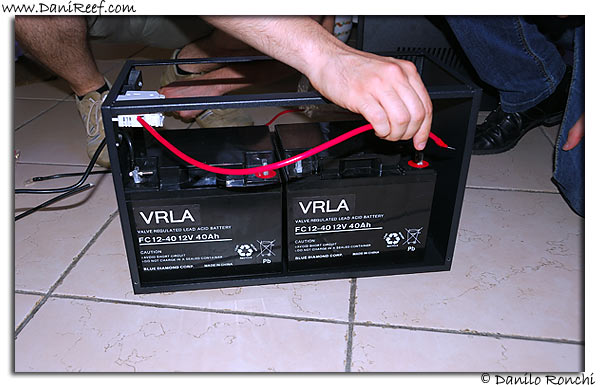
What can we connect to Zeus?
Choosing what to connect to Zeus is a very personal matter. From a theoretical point of view we consider that Zeus has to handle an emergency and does not ensure the full functioning of tank, then we must think of eliminating all the equipments are not strictly necessary as the lights for example. Secondly, we must consider to use that guarantees the user the maximum autonomy and oxygenation.
I don’t recommended the use of a heater or a chiller for the tank, because these equipments use an heavy amount of energy that the system would quickly run out. We have to consider that the tank will be lose his temperature only in many hours, so we do not worry about that.
The first equipment for these purposes is certainly an aerator, which consumes little (maximizing the time) and that ensures a good oxygenation. The negative points are that usually in a very populated tank there would one every 60 cm, preferably placed in middle position, and that should be cleaned continuously.
Then the second equipment that comes to mind with these features is the return pump (if we have it) or a movement pump placed just below the water level. Certainly the first consumes more and more, but allows the oxygen to mix with water when the water goes from tank to sump, and also guarantees a little movement in the tank which tends to scatter the well oxygenated water in aquarium.
The movement pump, if placed just below the surface, promotes the exchange gas and then slightly increases the level of oxygen.
One idea that has materialized in recent discussions on the Acquaportal forum, thanks to Emio’s mind is to insert a pump with venturi inlet just below the surface of the water. When stopping electric current, the level of the tank (if it is a reef aquarium with sump) tends to lower a few cm, enough to trigger the venturi pump, which then push air and water in the aquarium with good movement.
Obviously it is always possible to combine the various solutions, or even add the skimmer to the return pump, all in accordance with its own choices and the need for autonomy of each tank.
I among all the solutions I chose to use the Zeus to power my return pump.
I advise you also to buy a gsm module, which can warn of the lack of current, because we might be on holiday and Zeus could not physically hold several days of emergency.
The choice of batteries
As we have said before the batteries are sold separately and this gives us a tremendous flexibility in choosing them according to the load that we want and the time for which we wish that we be guaranteed the emergency.
Making an example on my case and considering my return pump with 35 watts, we can act in two ways:
Calculation of time to discharge, given the consumption:
We have to consider the sum of consumption of our equipments we want to keep in operation, in my case 35 watts, then we have to add 10 to this number, which is the consumption of Zeus during discharge. In my case 35 10=45. This number is divided by 24 (the voltage), then 45/24=1.87 which is the output current from the batteries. At this point we see the chart “Duration of discharge vs. Discharge current” shown below and on the value found in current output (discharge current) climb up to meet the curve of 77 ° fahrenheit (25 C) at this point you move horizontally until reading the duration of discharge which indicates the hours of battery.
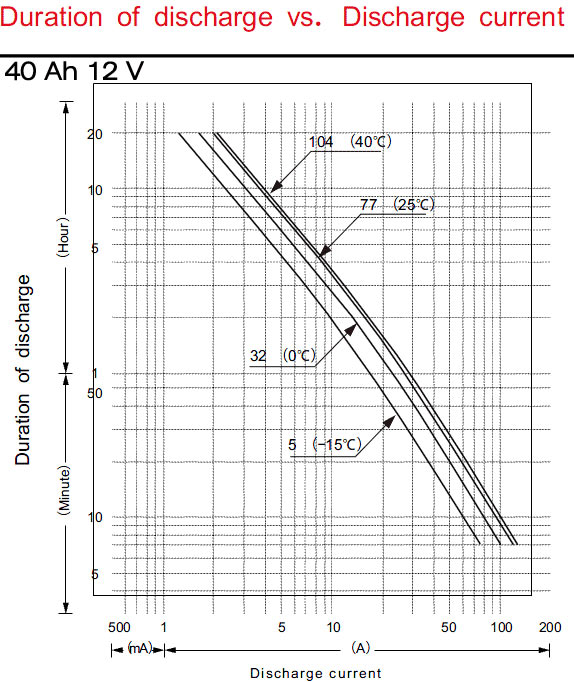
Calculating the capacity of batteries, given the time of discharge:
Similar to the above procedure is followed in reverse, to find the right battery given the load and the duration of discharge, in theory and in first approximation. Assuming for example, to protect the return pump, the skimmer and one movement pump, for a total of 120 watts, add 10 watts and we get 130 watts. Now we get the discharge current dividend 130 watts for the 24 volt and we obtain 5,41 ampere. If we want 15 hours of battery life, estimated in the first approximation, we must multiply 15×5,41 and get 81,15 Ah, so we should use two batteries in series to 12V and 40Ah, or a one battery 80Ah and 24v.
To be sure at this point we could use the procedure more precise explained above, provided that we have the graph of the battery.
The Test
As always, however, we must divide the theory from practice, and so I proceeded on my skin to measure objectively the duration of Zeus equipped with 2 batteries in series to 12V and 40Ah. My return pump has a power load of 35W. The theoretical calculation gives me a value autonomy more than 20 hours, not well defined because we are outside the graph provided. The test was conducted Saturday August 13 from 12.08, and was followed live on the forum here:
At the end Zeus has kept alive my pump for 25 hours and 43 minutes.
I think it’s a respectable value, a little more than theoretical assumptions, and that certainly gives us security in the medium term very very high.
The electricity
In our home we use alternating current, the evolution of the voltage in the time domain brings us back to the waveform of a sine wave.
The economic UPS tend to approximate a sine wave form with steps, in practice the wave instead of a continuous line like the one represented is made up of many small steps, the reason is that a wave, that is electricity, of this type is much easier to build and is sufficient for many applications. The pumps are typically quite sensitive equipment that may not start if the current is not sinusoidal and they could also to break.
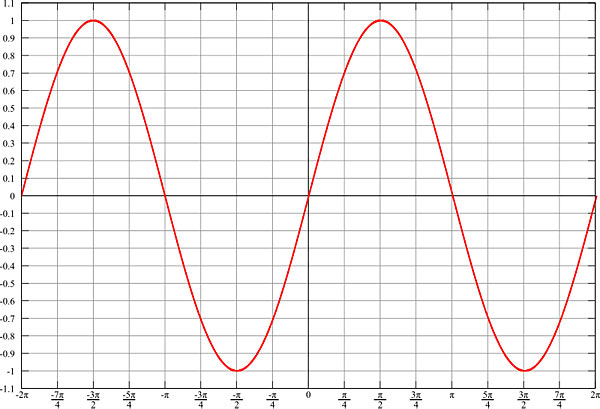
The UPS, uninterruptible power supply, is generally formed, in its simplest form from a battery that takes care of storing energy, an inverter that takes care of creating alternating current from direct current supplied by batteries, one or more microprocessors to control the system and a charger. Better is the inverter, better the quality of output current.
To test the goodness of sine wave, together with my friend Maurizio, We used an oscilloscope “Tektronix 2235A 100 Mhz” so that we can see with our eyes the waveform of current supplied by the operator Electrical Energy and by Zeus and we can compare them.
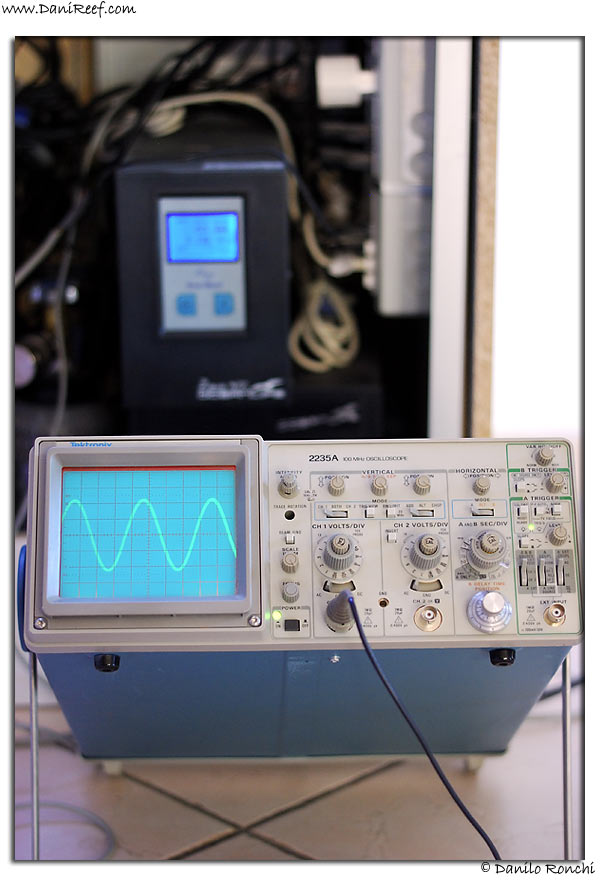
We then proceeded to detect the waveform of the electricity operator, which are below:
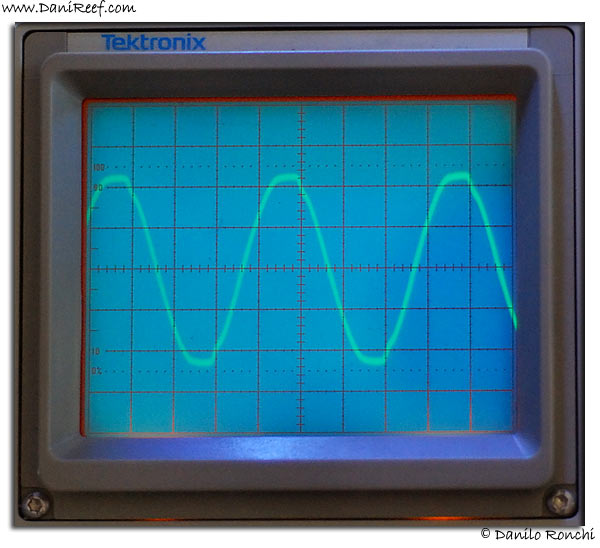
Where it is easy to see that the waveform is a sine wave all but perfect, and where we see a step after each wave, as well as a figure quite irregular.
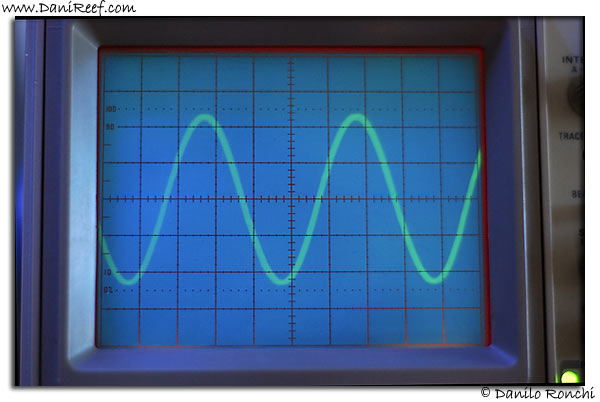
In this case the wave is a sine wave perfect! What really surprised us.
In practice the current output by Zeus is better, much better than direct from the network.
To give you a way to see more detail in the quality of sine wave and the difference with the electricity that comes to my house I shot three videos:
Test mode with Zeus and Oscilloscope:
Zeus:
Voltage:
The three videos are also available in high definition, AVCHD format and downloadable at:
General (77 mb)
Wave created by Zeus (22 mb)
Wave created by network (23 mb)
Conclusions
It’s very difficult to reach unequivocal conclusions on a subject like this. Technically it is unexceptionable, but his biggest enemy is linked to the perception of its actual need. In fact you could assimilate the Zeus to insurance, you pay an item that probably will not ever running, but that one must be ready whenever the opportunity will be presented. And since that one time could be crucial to keep alive its aquarium, well, its purchase, or purchasing something similar, it is highly recommended.
The Zeus is sold today at a list price of 199 euros excluding batteries, the batteries under test by 12V and 40Ah instead cost 85 euro each.








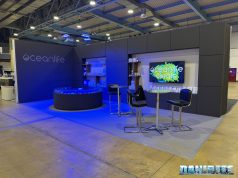


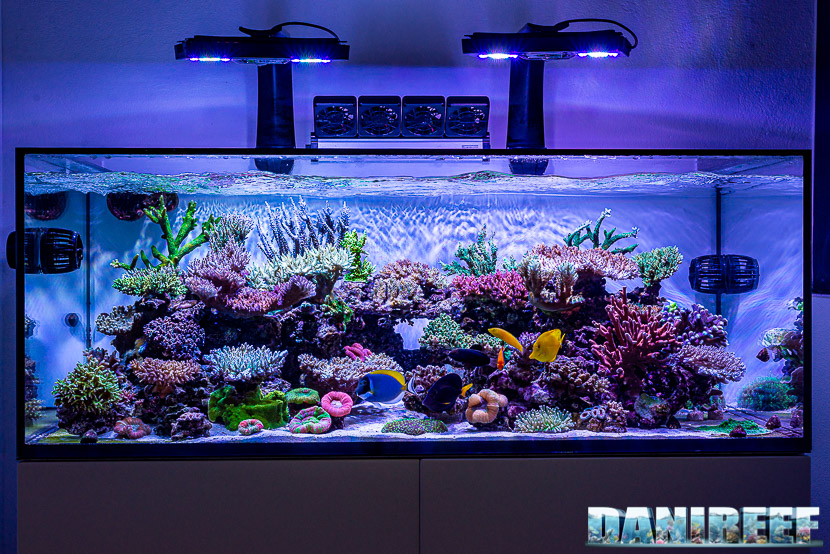




[…] For English version please click here […]
[…] electricity. Having tried on my own tank two systems of this kind of an APC UPS from 800VA, and the Zeus of Ocean Life with battery with 24V and 40Ah, I reported the autonomy of each pump with the two systems […]
Lead acid batteries should always be recycled because lead should never be dumped on the soil “
[…] Zeus, of which you can read a thorough review by clicking on the name, is a UPS (uninterruptible power supply) developed specifically to aquarium use, with an incredible value for money and enormous time of back up, especially if compared to the prices of UPS of the same backup time. […]